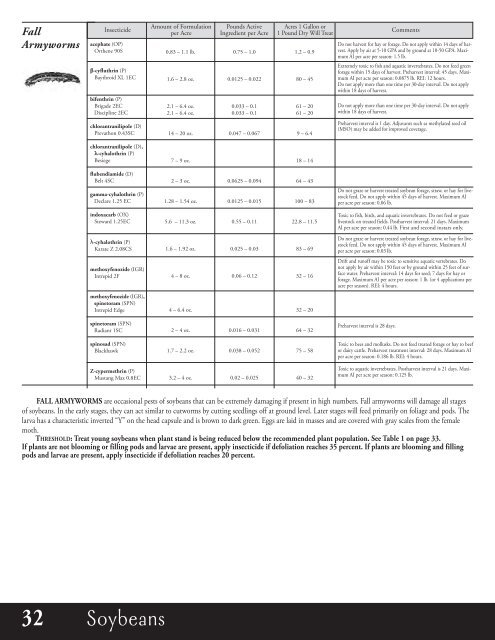Agronomic Crops
mJyPrJ
mJyPrJ
Create successful ePaper yourself
Turn your PDF publications into a flip-book with our unique Google optimized e-Paper software.
Fall<br />
Armyworms<br />
Insecticide<br />
acephate (OP)<br />
Orthene 90S<br />
b-cyfluthrin (P)<br />
Baythroid XL 1EC<br />
bifenthrin (P)<br />
Brigade 2EC<br />
Discipline 2EC<br />
Amount of Formulation<br />
per Acre<br />
0.83 – 1.1 lb.<br />
1.6 – 2.8 oz.<br />
2.1 – 6.4 oz.<br />
2.1 – 6.4 oz.<br />
Pounds Active<br />
Ingredient per Acre<br />
0.75 – 1.0<br />
0.0125 – 0.022<br />
0.033 – 0.1<br />
0.033 – 0.1<br />
Acres 1 Gallon or<br />
1 Pound Dry Will Treat<br />
1.2 – 0.9<br />
80 – 45<br />
61 – 20<br />
61 – 20<br />
Comments<br />
Do not harvest for hay or forage. Do not apply within 14 days of harvest.<br />
Apply by air at 5-10 GPA and by ground at 10-50 GPA. Maximum<br />
AI per acre per season: 1.5 lb.<br />
Extremely toxic to fish and aquatic invertebrates. Do not feed green<br />
forage within 15 days of harvest. Preharvest interval: 45 days. Maximum<br />
AI per acre per season: 0.0875 lb. REI: 12 hours.<br />
Do not apply more than one time per 30-day interval. Do not apply<br />
within 18 days of harvest.<br />
Do not apply more than one time per 30-day interval. Do not apply<br />
within 18 days of harvest.<br />
chlorantranilipole (D)<br />
Prevathon 0.43SC<br />
14 – 20 oz.<br />
0.047 – 0.067<br />
9 – 6.4<br />
Preharvest interval is 1 day. Adjuvants such as methylated seed oil<br />
(MSO) may be added for improved coverage.<br />
chlorantranilipole (D),<br />
λ-cyhalothrin (P)<br />
Besiege<br />
7 – 9 oz.<br />
18 – 14<br />
flubendiamide (D)<br />
Belt 4SC<br />
2 – 3 oz.<br />
0.0625 – 0.094<br />
64 – 43<br />
gamma-cyhalothrin (P)<br />
Declare 1.25 EC<br />
1.28 – 1.54 oz.<br />
0.0125 – 0.015<br />
100 – 83<br />
Do not graze or harvest treated soybean forage, straw, or hay for livestock<br />
feed. Do not apply within 45 days of harvest. Maximum AI<br />
per acre per season: 0.06 lb.<br />
indoxacarb (OX)<br />
Steward 1.25EC<br />
5.6 – 11.3 oz.<br />
0.55 – 0.11<br />
22.8 – 11.5<br />
Toxic to fish, birds, and aquatic invertebrates. Do not feed or graze<br />
livestock on treated fields. Postharvest interval: 21 days. Maximum<br />
AI per acre per season: 0.44 lb. First and second instars only.<br />
λ-cyhalothrin (P)<br />
Karate Z 2.08CS<br />
1.6 – 1.92 oz.<br />
0.025 – 0.03<br />
83 – 69<br />
Do not graze or harvest treated soybean forage, straw, or hay for livestock<br />
feed. Do not apply within 45 days of harvest. Maximum AI<br />
per acre per season: 0.03 lb.<br />
methoxyfenozide (IGR)<br />
Intrepid 2F<br />
4 – 8 oz.<br />
0.06 – 0.12<br />
32 – 16<br />
Drift and runoff may be toxic to sensitive aquatic vertebrates. Do<br />
not apply by air within 150 feet or by ground within 25 feet of surface<br />
water. Preharvest interval: 14 days for seed; 7 days for hay or<br />
forage. Maximum AI per acre per season: 1 lb. (or 4 applications per<br />
acre per season). REI: 4 hours.<br />
methoxyfenozide (IGR),<br />
spinetoram (SPN)<br />
Intrepid Edge<br />
4 – 6.4 oz.<br />
32 – 20<br />
spinetoram (SPN)<br />
Radiant 1SC<br />
2 – 4 oz.<br />
0.016 – 0.031<br />
64 – 32<br />
Preharvest interval is 28 days.<br />
spinosad (SPN)<br />
Blackhawk<br />
1.7 – 2.2 oz.<br />
0.038 – 0.052<br />
75 – 58<br />
Toxic to bees and mollusks. Do not feed treated forage or hay to beef<br />
or dairy cattle. Preharvest treatment interval: 28 days. Maximum AI<br />
per acre per season: 0.186 lb. REI: 4 hours.<br />
Z-cypermethrin (P)<br />
Mustang Max 0.8EC<br />
3.2 – 4 oz.<br />
0.02 – 0.025<br />
40 – 32<br />
Toxic to aquatic invertebrates. Postharvest interval is 21 days. Maximum<br />
AI per acre per season: 0.125 lb.<br />
FALL ARMyWoRMs are occasional pests of soybeans that can be extremely damaging if present in high numbers. Fall armyworms will damage all stages<br />
of soybeans. In the early stages, they can act similar to cutworms by cutting seedlings off at ground level. Later stages will feed primarily on foliage and pods. The<br />
larva has a characteristic inverted “Y” on the head capsule and is brown to dark green. Eggs are laid in masses and are covered with gray scales from the female<br />
moth<br />
ṫHResHoLD: treat young soybeans when plant stand is being reduced below the recommended plant population. see table 1 on page 33.<br />
If plants are not blooming or filling pods and larvae are present, apply insecticide if defoliation reaches 35 percent. If plants are blooming and filling<br />
pods and larvae are present, apply insecticide if defoliation reaches 20 percent.<br />
32 Crop Soybeans Name


